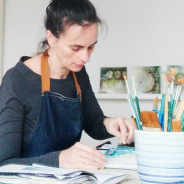Hi Everyone,
I have been wondering how designers make paint brushes of their own. I guess they paint in real life, scan and extract, but I'm really fuzzy on the extraction of a brush. How do you extract something with variating transparency? Are there any designers here willing to enlighten me?















do you mean brush files for Photoshop?
In Photoshop a brush is a file with an .abr extensions (adobe brush) and *generally* brush means more like what you would think of as a rubber stamp. There are tutorials all over the place on how to make a photoshop brush, probably Marisa has one, so I won't do that here.
If you mean brush, like a painters brush with bristles, I wouldn't bother trying to make one, I would just download from somewhere, there are tons out there and PS comes with a nice selection. In order to use a brush like a paint brush (and not a rubber stamp) there are different settings you can adjust in the brush panel, like pressure and scatter, etc.
Not sure if that is what you are asking or not...
You can use almost anything digital you can find and make a paint brush with it. Last night I took a picture of a rabbit, selected it, created a mask, than created a brush with it in Photoshop.
You can use coloring pages that are found in abundance on the web for kids, pictures from magazines, pictures you took, scans, etc.
What is nice is that all of the textures and lines are maintained within a grayscaled brush.
@Judy you make this look so easy. I have read several tuts about it but it seems much more difficult. Any possibility you could make a tutorial on the ins and outs? I would love a simple way to do it. I have CS6.
I just saw Marisa has a tutorial here on how to make a brush and also save it in a set in photoshop.
Brushes, or as Tina explained, stamps, can be made from anything. And if they are part transparent, that brush will stay transparent too.
Ya'll have some good responses! Brushes are so easy to make, almost anything can become a brush. The deal with transparency is this. With brushes, black is the color that appears the most solid. The lighter the shade, the more transparent the brush.
In the case of a brush that has multiple degrees of shades, you'll get multiple degree of transparency. The top circle is 100% black; the middle circle is 50% grey; and the bottom circle is white.
When you start with an image to turn into a brush, 'de-saturated' it, or use 'Black and White'. By adjusting the Levels, you can get darker or lighter shades of grey. Contrast is good! Look for more dark shades of grey to get better results.
Hope that helps!
Su
Great info ladies! I know I can turn just about anything into a brush and I love experimenting with that. I did mean to ask how designers (the ones that made all those pretty downloadable brushes) make the painted brushes. But now I realize that my question has been answered by you all, be it in a different way! I thought you had to get rid of all the whites (paper) around the painted parts, but Su made me understand that all white parts turn invisible the moment you turn them into a brush. Duh! How did I not think of that! I honestly thought brush-designers were somehow extracting the paint, LOL. I am such an idiot sometimes
I never realized that either Melo! Haha! I also spent lots of time wondering how people extracted those paint images....Feeling like a genius now!
Great info... thanks!
me too... so glad you asked this question Melo! I learned something very valuable here.
So glad I am not alone in my stupidity, haha!